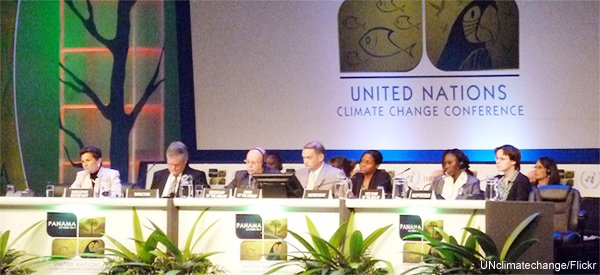I’ve just returned from a week of climate negotiations in Panama, the last session before the climate summit in Durban, South Africa, that starts the Monday after Thanksgiving.
While progress was made in Panama on some issues, there is no consensus on the big political issues: the future of the Kyoto Protocol, the related issue of creation of a more comprehensive long-term international climate treaty regime, and how to ramp up financing for developing country actions to deploy clean technology, preserve tropical forests, and adapt to the mounting impacts of climate change.
Without progress in Durban towards resolving some of the deep divisions among key countries on these issues, the momentum from last year’s climate summit in Cancún, Mexico, could be lost, and the effectiveness of the United Nations climate treaty process brought into question. Let’s look at where things stand on the knottiest of these issues — the future of Kyoto.
Whither Kyoto?
The Kyoto Protocol includes legally-binding emissions reduction commitments for industrialized countries for the five-year period ending in 2012 (the United States, of course, never ratified the Protocol, and so has no such obligations). Negotiations started almost six years ago on what those binding targets should be after 2012, but there are major differences on this issue.
What’s at stake is whether the world moves forward with the multilateral, rules-based approach that Kyoto represents, or shifts towards the voluntary, pledge-and review approach embodied in the Copenhagen Accord. My colleague Kelly Rigg, executive director of the Global Campaign for Climate Action (GCCA), outlines several reasons why the end of Kyoto would be a setback for global climate action here. (Full disclosure: I serve as Vice Chair of GCCA’s Board of Directors.)
Here’s where some of the key countries stand on this issue coming out of Panama:
- Canada, Japan, and Russia have each stated that they won’t take on targets in Kyoto’s “second commitment period,” and have called for replacing Kyoto with a more comprehensive treaty that includes obligations not only for the US, but for major developing countries such as China, India, and Brazil
- The European Union has already legislated deeper reduction targets for the 2013-2020 period, and has said it is willing to stay in Kyoto after 2012, but only if it’s a transition to a broader treaty with obligations for all big emitting countries starting no later than 2020.
- The BASIC group of major developing countries (Brazil, China, India, and South Africa) have called Kyoto the “cornerstone” of the climate treaty regime, and see progress on resolving its future as key to success in Durban.
- The Alliance of Small Island States (AOSIS), is also demanding action on Kyoto’s second commitment period, but wants negotiation of a parallel treaty with obligations for other major emitting countries as well.
- The United States has made clear it sees the Protocol’s “firewall” between commitments for developed and developing countries as a fatal flaw; it would be willing to negotiate a new instrument with legally binding reduction commitments, but only if it’s clear from the start that the “bindingness” of such a new regime will be the same for China and other major developing countries as for the US.
The US position was especially infuriating to many of the negotiators I spoke with in Panama, given the world’s experience with US on the Kyoto Protocol over the last decade (first, the Clinton administration pushed hard for the treaty to be designed exactly to its liking, but never submitted it to the Senate for ratification; then President Bush declared Kyoto “dead” only months after taking office).
After the failure of the climate bill in the United States Senate last year, these negotiators are quite aware of the near-impossibility of getting 67 Senators to vote to approve any treaty containig meaningful emissions reduction obligations for the US. Many of them see little point in trying to reach agreement with the US on yet another climate deal it can’t deliver on back home.
Prospects for a Deal in Durban
Given these sharply divergent positions, there is virtually no chance that a final agreement on the future of Kyoto will be reached in Durban. But the European Union is holding discussions with developing countries on a possible package deal that would include commitments by the EU and at least some other developed countries to stay in Kyoto after 2012, together with the launch of a process to negotiate a more comprehensive longer-term regime. Also, Australia and Norway tabled a detailed proposal in Panama, outlining how to ramp up mitigation actions by both developed and developing countries, that could represent a way out of the current stalemate.
We won’t know until the final hours of the Durban summit whether any compromise on Kyoto can be reached, especially given the US hard-line position on the terms for any new round of negotiations. And even if a deal is reached, adoption and ratification of the amendment to Kyoto needed to make any new commitments legally binding would almost certainly be linked to progress on the longer-term negotiations, leaving Kyoto’s status unresolved coming out of Durban.
If there is no clear path forward on Kyoto in Durban, it would be a blow to hopes for creation of a more comprehensive and ambitious multilateral treaty regime in the years ahead. Continued gridlock on Kyoto could also spur an angry response from a number of developing countries, leading them to block agreement on some or all of the decisions needed to build on last year’s Cancun summit, on issues ranging from adaptation to technology cooperation to reducing emissions from deforestation. This in turn would be a setback to the real progress on climate action being made on the ground in a growing number of countries. While nowhere near adequate, this progress represents a ray of hope that needs to be encouraged, not impeded.

